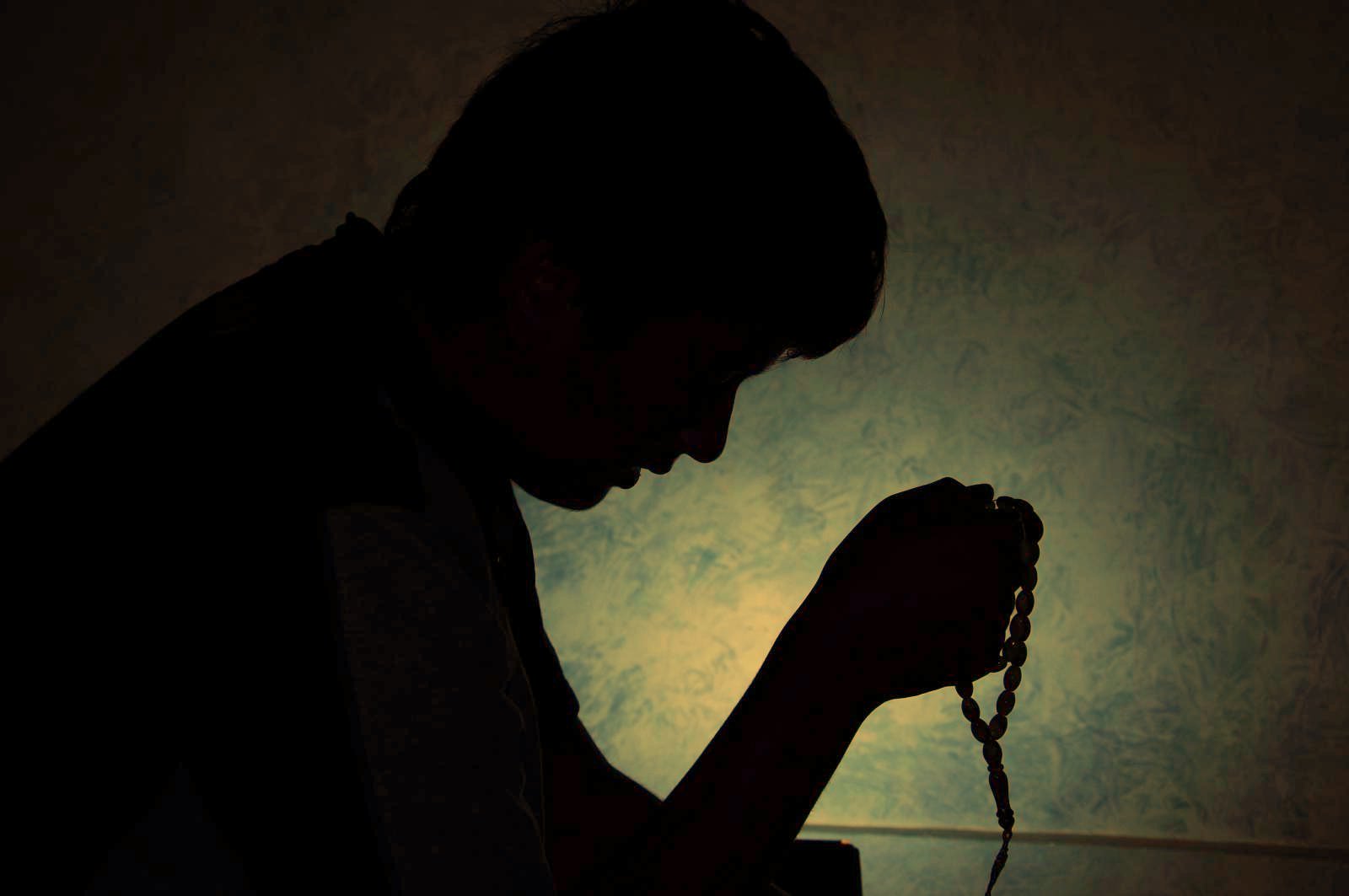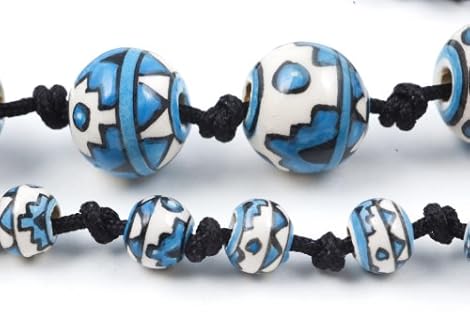
The use of prayer beads spans cultures and traditions the world over. It is one of the few religious symbols that is common across most major religions. What we call "prayer beads" can actually take three forms (one of which is not even made of beads):
- Necklace Prayer Beads - these are most common
- Wrist (Bracelet) Prayer Beads - these are smaller version of the necklace variety
- Prayer Rope - these are ropes or fabrics with knots tied in intervals, which serve the same purpose as beads.
Prayer beads are primarily used to keep track of prayers, meditation, or chants. They are basically a counting tool, though a sacred one. At a most basic level, they aid the practitioner by making the act of counting an automatic and unconscious effort, thus making it easier to concentrate on the content of the prayer, meditation, or chant. Just like there are three main types of prayer beads, there are also three main uses for them:
- Reciting the same thing repeatedly.
- Reciting a pattern of prayers, meditations, or chants, usually repeatedly.
- Contemplating an overall theme or idea (similar to the Catholic practice of Praying the Rosary).

The most commonly known Christian prayer beads are Catholic rosaries (from the Latin "rosarium" - "crown of roses"). There are many kind of rosaries, some with subtypes of their own.
Dominican - The Dominican rosary, also known as the "Five Decade Rosary", is by far the most common rosary. It is used by almost all Catholics, as well as some other denominations. When someone refers to simply a "rosary", odds are they are talking about a Dominican rosary. It consists of a single loop of 54 beads (5 decades of 10 beads each, plus 4 separators), plus 5 more beads hanging off the loop with a crucifix, for a total of 59 beads.
Franciscan - The Franciscan rosary comes in two different varieties, on consisting of 7 decades (for the Seven Joys of Mary) and another of 15 decades (for all 15 Mysteries).
Chaplets - Chaplets are usually smaller rosaries dedicated to one specific purpose. There are many different types of chaplets. The common Dominican rosary is technically a chaplet as well, but is usually classified separately due to its popularity. Another specific type of chaplet, the Servite Chaplet, is also singled out due its use of "weeks" (groups of 7 beads) instead of "decades".
Specialized - There are many kinds of more minor, specialized rosaries. One is the Wedding Rosary, which consists of two loops joined together, though it is mostly symbolic. There are also many kinds of single decade rosaries, wrist (bracelet) rosaries, auto (car) rosaries, and even rosary rings.
Ecumenical Miracle Rosary - Also known as the Anglican Rosary, and the Protestant Rosary, this rosary was presented on the Web in 1999 and quickly gained acceptance by most Protestant and Roman Catholic groups. It was designed to be a non-denominational experience that could be shared by all Christians. It consists of 4 weeks, for a total of 33 beads. It is also used by many Gnostic groups.
Kombologion - Also known as Greek Prayer Ropes, these look similar to rosaries, but are made entirely out of fabric, cloth, or rope, knotted together to look like beads. They are commonly used in Eastern Orthodox traditions.
 |
| A Greek Kombologion |

Although Judaism considers the use of prayer beads to be a pagan practice, they still have something similar in the tallit. The tallit is a prayer shawl, with tassels around the edges that are knotted a specific number of times. They serve a very similar purpose to prayer beads.

Muslim Prayer Beads
Masbaha - The masbaha (مسبحة), also known as a sibha (سبحة) or a tasbih (تسبيح), consists of 99 beads. It used to pray the 99 Names of Allah, as found in the Qur'an. Although commonly used by most Muslims, there are some groups that are adamantly opposed to use of anything to count prayers, aside from their own fingers.
Hindu Prayer Beads
Vedic and Hindu prayer beads are known as Japa Mala (जप माला) and consist of 108 beads. Usually they are divided into four groups of 27 beads, but not always. There are also smaller, 27 bead wrist malas. In Tibet, it was traditional to make mala out of the bones of holy men. But today, that tradition has been replaced by the use of yak bones instead. There is wide-ranging significance both to the color and the material of the beads. Japa malas are typically used when reciting mantras. There are also specialized malas, known as "planetary malas" that are interspersed with gemstones representing the planets, the Sun, the moon, and other elements of Vedic astrology.

Buddhist and Daoist Prayer Beads
Buddhist and Daoists also use 108 bead malas, though they differ slightly from the Hindu malas. Chinese malas are typically divided into three groups of 36 beads. Though normally known as shu zhu (数珠), technically there are four types of Chinese prayer beads, depending on their intended purpose. Shu zhu are counting beads, Fo zhu are Buddhist beads, Nian zhu are prayer beads, and Chao zhu are court beads.
In Daoist traditions, malas are not only used for prayer, meditation, and chanting, but also for various types of mystical training, including divination and incantations. As in Hindu traditions, the material of the mala is important. Daoists usually categorize the materials into four types: wood, stone, metal, and bone. In some Tibetan sects, the most sacred beads are the ones made from the skull bones of holy men.
It is worth noting here that Vedic, Hindu, Buddhist, and Daoist mala are all centered around the number 108. This number is considered sacred and mystical in many cultures, and a more detailed analysis of it will be presented in a future article.

Many other cultures around the world also use prayer beads. For example, some Native American tribes, such as the Cherokee, use strands of prayer beads of "affirmation beads".

Prayer beads can also be found in many African cultures, such as the Yoruba and the Maasai. They are usually worn and are thought to embody spiritual power, which they can convey to the wearer. They are also used in many rituals and are believed to be ably to channel the power of the gods.

South America also has its share of prayer beads, the most famous of which are Peruvian Prayer Beads, which are usually made of ceramic. These beads are usually used in pairs, symbolizing both the male and female essence, and are thought to represent the journey of transforming from a human, into a star, and eventually back again.
This is by no means an extensive list. Prayer beads can be found virtually everywhere, in some form or another. Even many modern traditions, especially pagan ones, have begun adopting the idea. Modern Druidic groups, Wicca, and others have their own versions of rosaries or prayer beads. What they all have in common is that they hold the beads sacred and believe them to be the source of something greater than themselves.





Hi! I'm doing research on the many different kinds of prayers beads. I'm a devout Catholic, and the Rosary means very much to me, even so that there is one in every room of my house, and I wear one wrapped around my wrist always.
ReplyDeleteThe research I'm doing focuses on the regard other cultures--religious and secular both--place on ropes of beads, the clacking and counting of them, the devotion that is shown by them. I'm having a hard time tracking down the existence of some, the method of use of others. Specifically regarding Native American possession and usages, the escape of which galls me mightily. I'd greatly appreciate your thoughts or even research you'd still have.
Whichever road, this article was very, VERY interesting and extremely helpful, and I thank you for the time you put into it.